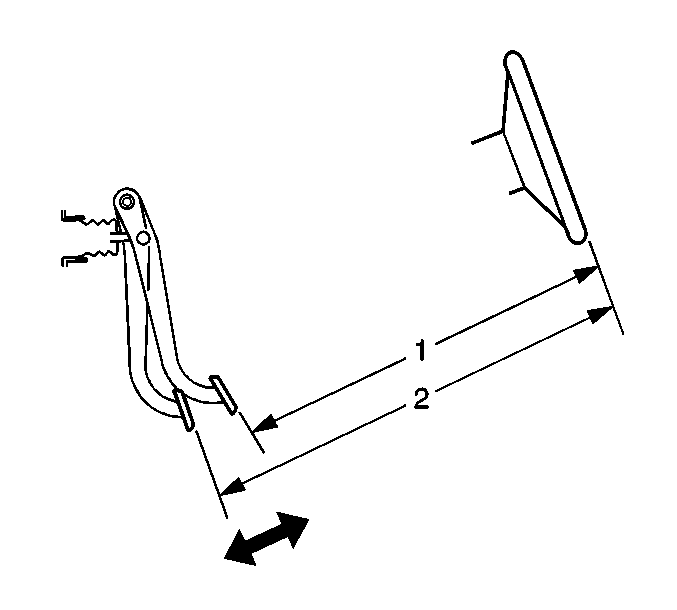Chevrolet Equinox Service Manual: Brake Pedal Travel Measurement and Inspection Hydraulic Brakes Brake Pedal Assembly
Special Tools
J-28662Brake Pedal Effort Gauge, or equivalent
With the ignition OFF and the brakes cool, apply the brakes3–5-times, or until the brake pedal becomesfirm, in order to deplete the brake booster power reserve.Install theJ-28662Brake Pedal Effort Gauge, or equivalentto the brake pedal.
Measure and record the distance-(1) from the brakepedal to the rim of the steering wheel; note the points ofmeasurement.Apply and maintain the brakes with 445-N(100-lb) of force to the brake pedal, as indicated ontheJ-28662Brake Pedal Effort Gauge, or equivalent.While maintaining 445-N (100-lb) offorce to the brake pedal, measure and record thedistance-(2) from the same point on the brake pedal tothe same point on the rim of the steering wheel.Release the brakes and repeatsteps-4-and-5 to obtain a secondmeasurement. After obtaining a second measurement, proceed tostep-7.Average the first and second measurements recorded during thetwo applies of the brakes.Subtract the initial measurement, unapplied-(1),from the averaged, applied measurement-(2) to obtain thebrake pedal travel distance.
Specification
Maximum brake pedal travel measured with the ignition OFF,power vacuum brake booster vacuum reserve depleted, and the brakescool: 57-mm (2.24-in).
 Parking Brake Adjustment Parking Brake
Parking Brake Adjustment Parking Brake
Special ToolsJ-21177-ADrum-to-Brake Shoe Clearance GaugeWarning:Refer toBrake Dust Warning.Apply and fully release the park brake.Verify that the park brake pedal releases completely.Turn ON the ignit ...
 Parking Brake Lever Replacement Parking Brake Lever or Pedal
Parking Brake Lever Replacement Parking Brake Lever or Pedal
Special ToolsJ-37043Parking Brake Cable Release ToolRemoval ProcedureRaise and support the vehicle. Refer toLifting and Jacking the Vehicle.Loosen the park brake cablelocknut-(1)-at the equalizer to r ...
Other materials:
Balance Shaft to Engine Timing (LAF, LEA, or LUK) Engine Block Cylinder Block Balance Shaft
Install the balance shaft drive sprocket.Note:If the balance shafts are not properly timed to the engine,the engine may vibrate or make noise.Install the balance shaft drive chain with the colored linkslined up on with the marks on the balance shaft drive sprockets andthe crankshaft sprocket. There ...
